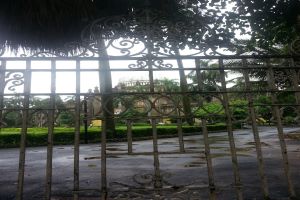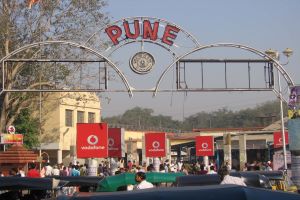Note: This post was originally published on July 7th, 2013.
The Palkhi
It’s been four days since my birth country’s independence day, and I am in India – performing research in my mother country, embracing my heritage, and wondering how a month has already passed by since I first arrived in India. To my utter bewilderment, this date marks my half way point as a Khorana Scholar, and I therefore saw it fitting that I devote this blog post to reflecting on my academic and cultural learnings and struggles- an evaluation of my experience thus far, at the end of the sixth week.
This past week on Monday-Wednesday, the Palkhi, a religious pilgrimage honoring two Indian saints, Sant. Tukaram Maharaj and Sant. Dnyaneshwar Maharaj, passed through Pune. It was a HUGE procession, featuring thousands of devotees, and a beautifully adorned chariot for the murti or small statue of the figure. Roads across Pune were closed! To make this long, rather bland, post more visually appealing, check out this picture of the palkhi. Though I didn’t dare venture into the streets, to see it, I saw much of the remnants of this large-scale event in the heart of Pune. I also really enjoyed viewing it on TV! Maybe someday next time I visit India I’ll actually check it out, perhaps even participate in it ??!!
Research Updates
I always highlight and ponder over my cultural insights on Indian culture, leaving less space for my academic learnings- which is, actually what brought me to India! My experience in a research environment in another nation has been a roller-coaster, in all honesty. It’s been a challenge to immerse myself in a different culture and a new lab atmosphere, all at once.
In many ways, my experience as a research intern in India has been exciting and honestly, refreshing- especially being able to work on a different schedule (from in the states), meeting new people and hearing unique perspectives both on science and culture. Through other angles, yet, the experience has been a bit disappointing and challenging, as well. Let’s view my internship in India as a glass half full.
There are various aspects of Indian labs, which distinguish them from equivalent American labs. First, and foremost, is the lab culture. Inscribed within Indian cultural norms is a unique laid-back attitude. I learned, during my first week in the lab, for instance, that there are nearly 3-4 tea breaks in one workday. It seemed like I was in the canteen more than in the lab! After a few days, however, I realized that tea breaks, like many other things, are normal, expected, and thus, should be celebrated as part of the lab culture. Besides, I’ve found, after a few hours of monotonous work, it can be revitalizing and exciting to chat over chai.
In regards to academic research, my experience working in IISER-Pune so far has been, in my eyes, comparable to that at many high-tech American institutions. My first three weeks, I worked at a bio-photonics lab. The wet-lab contained a high-quality Raman Spectroscope, safety materials and supplies. The main issue I saw was space. Granted, the lab was in the late stages of moving to a newer facility, but the machinery, technology, etc. seemed to be especially crowded, as compared to a similar lab in U.S. Another difference I’ve noticed between Indian and U.S. labs, or lab personnel, more particularly, is the extremely helpful/cooperative culture. For instance, especially in my old lab, my mentors were extremely courteous and enthusiastic about sharing their knowledge-being students themselves. Though I know IISER-Pune is an extremely cut throat and intense institution, it also appears that there is a flip side to this competitive spirit, and a general sense of cooperation within the lab community. Of course, this may simply be my naïve observance.
Since working in my new lab, I have not gotten any “hands on” experience, as I had initially desired. My new research, as stated earlier, is to characterize zebra finch songs, using MatLab and sonograms to visualize the songs. The production of song parallels movement production in humans. On the neurological level, neurons fire a different pattern before producing notes of the actual song, showing that it takes time to orient itself or prime itself. Eventually, we wish to use this knowledge to understand how the brain uses introductory notes as a preparatory mechanism, and what this shows about movement control in humans. My specific project is also coming to shape. It will involve using MatLab to visualize songs of normal and deafened zebra finches (deafened early in development) and understand the difference in the pattern of introductory notes (IN) in these two groups.
Learning MatLab has been an interesting exercise in itself, but soon, once I become comfortable with the computer program, I will shift into data analysis- actual “work”.
“Simply being in India has been so valuable…”
Looking over my entire experience in India so far, I would say that it has been fulfilling, reinvigorating and – in a way – reaffirming. Simply being in India has been so valuable; being so close to my extended family, culture, beauty and nature. I’ve learned a lot both in and outside of the lab. I can’t wait to see what the next weeks bring! Though I also can’t bear the depressing thought that I only have 5 weeks left in India.
When I’m not in the lab, I have also began a short hospital visitation program at KEM Hospital, a large, private hospital in Pune, Maharashtra. For the first time last week, I was able to shadow physicians in the Neonatal Intensive Care Unit. Over the coming 3 weeks, I will be able to rotate through different departments within the Pediatric ward of the hospital, and hopefully, gain insight into the differences between the Indian and U.S. Medical Systems. Perhaps one of the more exciting parts of this experience, will be the opportunity to visit the Vadu Project, which is a unique hospital providing healthcare services within rural Maharashtra.

More on my volunteer experience in the Neonatal Intensive Care Unit (NICU) appears in the next blog post.




